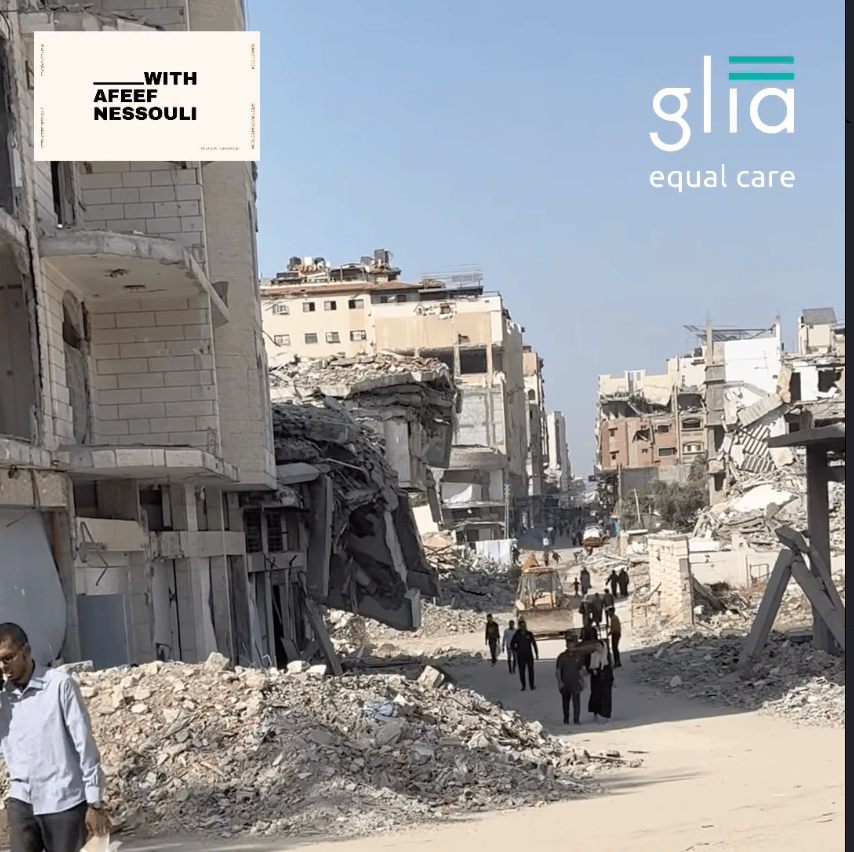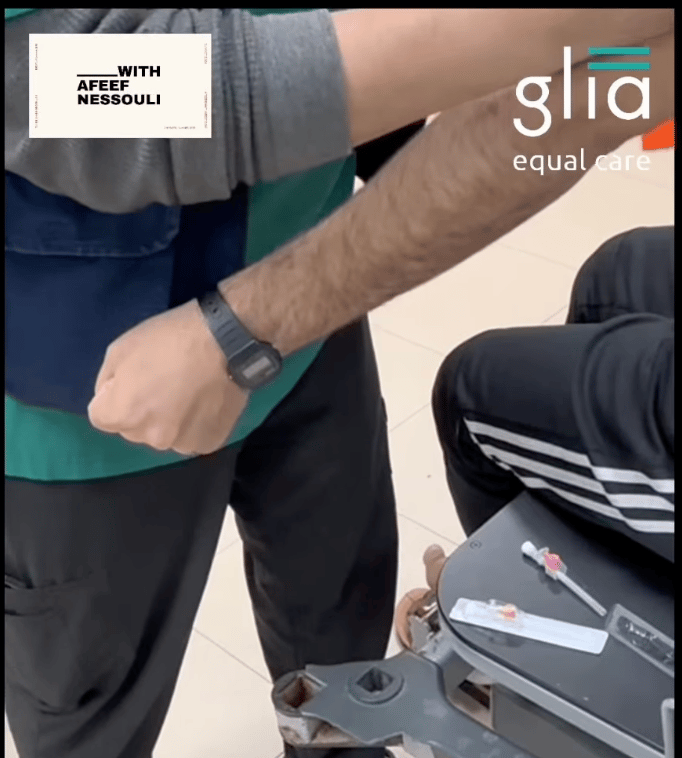- Debrief - The undercover dispatch
- Posts
- The International Journalist Who Entered Gaza (as a humanitarian volunteer)
The International Journalist Who Entered Gaza (as a humanitarian volunteer)
Three months under siege, amid hunger, snipers, and a news blackout.

Afeef Nessouli is one of the very few international journalists to have set foot in Gaza since October 7, 2023 — not counting those embedded with Israeli forces. To do so, he had to conceal the fact that he was a journalist.
Since 2023, media outlets from around the world have been requesting permission to enter Gaza, but Israel has consistently blocked all access.
And yet, a few months ago, an American journalist managed to enter the Strip by posing as a humanitarian volunteer for an NGO. Afeef Nessouli joined a team of doctors and nurses headed into the besieged enclave to provide assistance.
Thanks to this risky cover, he was able to witness firsthand the horrors unfolding in Palestine.
This issue of Debrief is dedicated to his story. And even though it’s not exactly an undercover investigation, it clearly shows why sometimes it’s truly necessary to lie about your identity in order to reveal the truth.
Today’s issue is written by Sacha and edited by Luigi.
In questo numero di Debrief:
Three Months Inside Gaza
Afeef Nessouli is an American journalist who writes for The Intercept and has been covering the Middle East for over a decade, with a focus on the Occupied Palestinian Territories. Based in New York City (though often working from Beirut), Nessouli has reported on conflict and human rights issues since 2011, often highlighting the experiences of marginalized communities. In particular, he became one of the few journalists to give voice to the Palestinian LGBTQ+ community after October 2023.
In late March 2025, he joined a Palestinian-led medical aid organization called Glia International, a nonprofit that brings international medical staff into Gaza to support local healthcare workers. By registering with Glia as a logistics coordinator, he obtained the clearance necessary to enter the Strip at a time when journalists were banned.
For about three months (from March 27 to June 3, 2025), Nessouli lived inside Gaza, working as a genuine humanitarian volunteer. “I went in with Glia. I think that it’s really important to realize that right now Palestinian journalists are suffering because of malnourishment. But for the last year and a half, two years, they’ve been on the frontlines. I don’t think that they necessarily needed me to go in as a journalist. What they needed was someone to help on the ground, which is what I did,” he explained after returning. During those weeks, he took on many roles: coordinating ambulances during mass-casualty events, helping in community kitchens, distributing water, and assisting in orphanages.
But in the (little) time he had left, he also gathered testimonies and sources for his journalistic work. He interviewed doctors, patients, and residents, took notes on what he witnessed, and documented evidence of the ongoing humanitarian crisis. As he himself pointed out, Palestinian journalists on the ground were already risking their lives to cover the story, so his first duty was to physically help on site.
The reality he experienced was the same one Palestinians live every day. “I even lost about 10 pounds to 12 pounds,” he noted, because aid volunteers had to endure the same scarcity as everyone else. “Because we were having one meal a day,” Nessouli recounted — and that was at the beginning. Conditions only got worse.

A screenshot from Nessouli report
Starving to Death — or for a Piece of Bread
“It has been an incredibly awful experience to see people sort of become sicker and sicker from hunger,” he said in an interview after returning, describing scenes he had witnessed firsthand. Before the war, a network of community kitchens fed nearly half the population. By the time he left, those kitchens had virtually collapsed: from 250,000 meals a day to a meager 25,000, until food stocks were entirely depleted.
One day, the volunteers at Shabab Gaza (a community kitchen he helped at) had nothing left to cook except a pile of potatoes. That became the last meal for many, with no idea of when the next would come. Desperate residents approached Nessouli on the street, pleading to know if he had any flour or tahini hidden in the aid truck. “We really don’t have flour,” he would reply. “We’re also really hungry.” As food stocks ran out, death by starvation was added to the list of daily threats.
During Nessouli’s time operating in Gaza, Israel and the United States implemented a new system of aid distribution centers managed by the so-called Gaza Humanitarian Foundation (GHF). In theory, the GHF was meant to replace the dozens of U.N. food sites that had previously operated. In practice, it created four heavily guarded distribution hubs where thousands of starving people queued for hours — often overnight — hoping to receive a small parcel of basic goods. Nessouli witnessed how these breadlines turned into death zones. “From my reporting and my experience, people are shot at, very regularly shot at,” he told Democracy Now!, describing sniper fire on the crowds waiting for aid.
Doctors in Gaza were treating civilians with gunshot wounds to the back of the head — characteristic of sniper fire. On May 26, during the first GHF food handout, chaos erupted. Shots were fired as the crowd surged forward. Khalil, a 26-year-old from Gaza who had been waiting in line, described the scene: “They began shooting directly at unarmed civilians,” Nessouli reported on The intercept. “The bullets were chasing us as if we were targets on a shooting range, and not just hungry people. We scattered under a hail of bullets. I got closer to death that day than a piece of bread.”
Press Access Ban
As remarkable as Nessouli’s story is, it’s not the first time a journalist has entered Gaza without being embedded with the Israeli military. In December 2023, Clarissa Ward of CNN also succeeded in doing so. She is considered the first Western journalist to have set foot in Gaza since October 2023. Ward crossed the Rafah border with a humanitarian convoy of Emirati medical volunteers. She and her small crew squeezed into the back of an aid worker’s car and entered the southern part of the Strip, cameras rolling. She stayed only a few hours — enough time to film the devastation in Rafah: bombed-out buildings and crowds of displaced families picking their way through piles of rubble.
The subterfuge used by Nessouli and Ward was necessary because of the ban Israel imposed on foreign journalists, enforcing a total media blackout in the territory. Hundreds of Palestinian journalists inside Gaza who continued their work have paid with their lives. As of mid-2025, nearly 200 journalists and media workers had been killed, the vast majority by Israeli airstrikes — making this the deadliest conflict for reporters in recent decades. International press freedom organizations have sounded the alarm. In June, over 200 media outlets and editors signed an open letter urging Israel to lift the ban, calling the exclusion of independent media “unprecedented in modern warfare.” Global news agencies such as the BBC, AP, Reuters, and AFP publicly demanded access, emphasizing that their journalists in Gaza were starving under siege. “We are deeply concerned for our journalists in Gaza, who are increasingly unable to feed themselves and their families,” the agencies warned. But those appeals were met with silence or indifference by Israeli authorities — and the press blackout continues.
The story of famine in Gaza was supposed to remain hidden, or told only through official propaganda. But thanks to the reporting of Palestinian journalists on the ground — and to the audacity of Afeef Nessouli — it reached the world’s attention.
In circumstances like these, the only way for international journalists to do their job has been to not identify as journalists at all.
Until the next Debrief,
Luigi e Sacha
If you've come across an undercover investigation you think we should feature, share it with us here:
👉 https://forms.gle/1JbqMBJUfoRU9MBp7
If you have suggestions, questions, tips (or insults), drop us a line at:
👉 [email protected]
If you enjoyed this newsletter, pass it along to your friends using this link:
👉 https://debrief-newsletter.beehiiv.com/
Follow us on Instagram, occasionally we'll upload content different from the newsletter:
👉 https://www.instagram.com/debrief_undercover/
We've also launched a podcast featuring interviews with the authors of memorable undercover investigations:
👉 https://open.spotify.com/show
And if that's still not enough, join our Telegram channel, where we can keep the conversation going:
👉 https://t.me/debrief_undercover
Reply